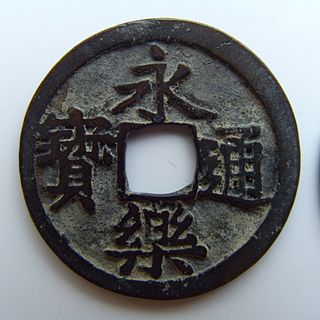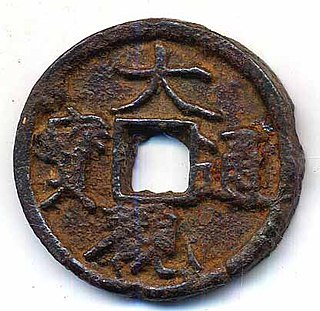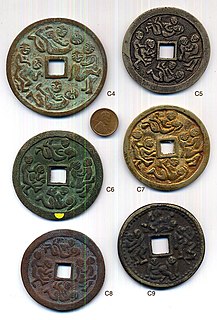
The Later Zhou was the last in a succession of five dynasties that controlled most of northern China during the Five Dynasties and Ten Kingdoms period, which lasted from 907 to 960 and bridged the gap between the Tang Dynasty and the Song Dynasty.

Ancient Chinese coinage includes some of the earliest known coins. These coins, used as early as the Spring and Autumn period (770–476 BCE), took the form of imitations of the cowrie shells that were used in ceremonial exchanges. The same period also saw the introduction of the first metal coins; however, they were not initially round, instead being either knife shaped or spade shaped. Round metal coins with a round, and then later square hole in the center were first introduced around 350 BCE. The beginning of the Qin Dynasty (221–206 BCE), the first dynasty to unify China, saw the introduction of a standardised coinage for the whole Empire. Subsequent dynasties produced variations on these round coins throughout the imperial period. At first the distribution of the coinage was limited to use around the capital city district, but by the beginning of the Han Dynasty, coins were widely used for such things as paying taxes, salaries and fines.

Cash was a type of coin of China and East Asia, used from the 4th century BC until the 20th century AD, characterised by their round outer shape and a square center hole. Originally cast during the Warring States period, these coins continued to be used for the entirety of Imperial China as well as under Mongol and Manchu rule. The last Chinese cash coins were cast in the first year of the Republic of China. Generally most cash coins were made from copper or bronze alloys, with iron, lead, and zinc coins occasionally used less often throughout Chinese history. Rare silver and gold cash coins were also produced. During most of their production, cash coins were cast, but during the late Qing dynasty, machine-struck cash coins began to be made. As the cash coins produced over Chinese history were similar, thousand year old cash coins produced during the Northern Song dynasty continued to circulate as valid currency well into the early twentieth century.

Chinese coinage in the Ming dynasty saw the production of many types of coins. During the Ming dynasty of China, the national economy was developed and its techniques of producing coinage were advanced. One early period example is the Bronze 1 cash. Obverse: "Hongwu Tongbao" (洪武通寶). Reverse: blank. Average 23.8 mm, 3.50 grams.

The Yuan dynasty was a Mongol-ruled Chinese dynasty which existed from 1271 to 1368. After the conquest of the Western Xia, Western Liao, and Jin dynasties they allowed for the continuation of locally minted copper currency, as well as allowing for the continued use of previously created and older forms of currency, while they immediately abolished the Jin dynasty's paper money as it suffered heavily from inflation due to the wars with the Mongols. After the conquest of the Song dynasty was completed, the Yuan dynasty started issuing their own copper coins largely based on older Jin dynasty models, though eventually the preferred Yuan currency became the Jiaochao and silver sycees, as coins would eventually fall largely into disuse. Although the Mongols at first preferred to have every banknote backed up by gold and silver, high government expenditures forced the Yuan to create fiat money in order to sustain government spending.

The Western Xia was a Tangut-led Chinese dynasty which ruled over what are now the northwestern Chinese provinces of Ningxia, Gansu, eastern Qinghai, northern Shaanxi, northeastern Xinjiang, southwest Inner Mongolia, and southernmost Outer Mongolia from 1032 until 1227 when they were destroyed by the Mongols. The country was established by the Tangut people; likewise its earliest coins were escribed with Tangut characters, while later they would be written in Chinese. Opposed to Song dynasty coins that often read top-bottom-right-left, Western Xia coins exclusively read clockwise. Despite the fact that coins had been cast for over a century and a half, very little were actually produced and coins from Western Xia are a rarity today. Although the Western Xia cast their own coins barter remained widely used.

The Kaiyuan Tongbao, sometimes romanised as Kai Yuan Tong Bao or using the archaic Wade-Giles spelling K'ai Yuan T'ung Pao, was a Tang dynasty cash coin that was produced from 621 under the reign of Emperor Gaozu and remained in production for most of the Tang dynasty until 907. The Kaiyuan Tongbao was notably the first cash coin to use the inscription tōng bǎo (通寶) and an era title as opposed to have an inscription based on the weight of the coin as was the case with Ban Liang, Wu Zhu and many other earlier types of Chinese cash coins. The Kaiyuan Tongbao's calligraphy and inscription inspired subsequent Central Asian, Japanese, Korean, Ryūkyūan, and Vietnamese cash coins and became the standard until the last cash coin to use the inscription "通寶" was cast until the early 1940s in French Indochina.

The Zhengde Tongbao is a fantasy cash coin, Chinese, and Vietnamese numismatic charm bearing an inscription based on the reign title of the Zhengde Emperor of the Ming dynasty. The Zhengde Emperor reigned from the year 1505 until 1521, however during this period no circulating cash coins were minted. There were a large amount "cash coins" bearing the Zhengde era name are minted from the late Ming to early Qing dynasty periods as superstitious "lucky coins" with auspicious depictions and instructions, as this inscription remained popular for charms modern reproductions of the Zhengde Tongbao are also very common.

The Yongle Tongbao was a Ming dynasty era Chinese cash coin produced under the reign of the Yongle Emperor. As the Ming dynasty didn't produce copper coinage at the time since it predominantly used silver coins and paper money as the main currency, the records vary on when the Yongle Emperor ordered its creation between 1408 and 1410, this was done as the production of traditional cash-style coinage had earlier ceased in 1393. The Yongle Tongbao cash coins were notably not manufactured for the internal Chinese market where silver coinage and paper money would continue to dominate, but were in fact produced to help stimulate international trade as Chinese cash coins were used as a common form of currency throughout South, Southeast, and East Asia.
The coinage of the Great Shu Kingdom is the earliest known coinage produced by a peasant revolt in the history of China, the revolt lasted from 993 until 995 and during this period a small number of cash coins were produced by the peasant rebellion using the era names of the rebel leader Li Shun. It was only with the strongest military efforts that the Song dynasty was able to suppress the rebellion and restore their rule over the Shu region. The coinage produced by the Da Shu Kingdom is often rather roughly produced and as the rebellion only lasted a few years not many cash coins were produced leading to them being extremely rare today.

Kangxi Tongbao refers to an inscription used on Manchu Qing dynasty era cash coins produced under the reign of the Kangxi Emperor. Under the Kangxi Emperor the weights and standards of the brass cash coins changed several times and the bimetallic system of Qing dynasty coinage was established. Today Kangxi Tongbao cash coins are commonly used as charms and amulets where different forms of superstition have developed arounds its mint marks and calligraphy.

Qianlong Tongbao is an inscription used on cash coins produced under the reign of the Qianlong Emperor of the Qing dynasty. Initially the Qianlong Tongbao cash coins were equal to its predecessors in their weight and quality but as expensive military expenditures such as the Ten Great Campaigns began to take their financial toll on the government of the Qing dynasty the quality of these cash coins started to steadily decrease. The weight of the Qianlong Tongbao was changed several times and tin was added to their alloy to both reduce costs and to prevent people from melting down the coins to make utensils. As the intrinsic value of these coins was higher than their nominal value many provincial mints started reporting annual losses and were forced to close down, meanwhile the copper content of the coinage continued to be lowered while the copper mines of China were depleting. The Qianlong era also saw the conquest of Xinjiang and the introduction of cash coins to this new region of the Qing Empire.

Daqian are large-denomination cash coins produced in the Qing dynasty starting from 1853 until 1890. Large denomination cash coins were previously used in earlier Chinese dynasties and had faced similar issues as 19th-century Daqian. The term referred to cash coins with a denomination of 4 wén or higher.

Bingqian, or Bingxingqian, is a term, which translates into English as "biscuit coins", "pie coins", or "cake coins", used by Chinese and Taiwanese coin collectors to refer to cash coins with an extremely broad rim as, these cash coins can also be very thick. While the earliest versions of the Bingqian did not extraordinarily broad rims.

Buddhist coin charms are a category of Chinese, Japanese, Korean, and Vietnamese numismatic charms that depict Buddhist religious imagery or inscriptions. These coin charms often imitate the design of Chinese cash coins, but can exist in many different shapes and sizes. In these countries similar numismatic charms existed for Confucianism and Taoism, and at times Buddhist coin charms would also incorporate symbolism from these other religions.

Standard cash, or regulation cash coins, is a term used during the Ming and Qing dynasties of China to refer to standard issue copper-alloy cash coins produced in imperial Chinese mints according to weight and composition standards that were fixed by the imperial government. The term was first used for Hongwu Tongbao cash coins following the abolition of large denomination versions of this cash coin series.

"Red cash coins" are the cash coins produced in Xinjiang under Qing rule following the conquest of the Dzungar Khanate by the Qing dynasty in 1757. While in Northern Xinjiang the monetary system of China proper, with standard cash coins, was adopted in Southern Xinjiang where the pūl (ﭘول) coins of Dzungaria circulated earlier the pūl-system was continued but some of the old Dzungar pūl coins were melted down to make Qianlong Tongbao (乾隆通寶) cash coins, as pūl coins were usually around 98% copper they tended to be very red in colour which gave the cash coins based on the pūl coins the nickname "red cash coins".

Iron cash coins are a type of Chinese cash coin that were produced at various times during the monetary history of imperial China as well as in Japan and Vietnam. Iron cash coins were often produced in regions where the supply of copper was insufficient, or as a method of paying for high military expenditures at times of war, as well as for exports at times of trade deficits.

Marriage coin charms are a category of Chinese, Japanese, Korean, and Vietnamese numismatic charms that depict marriage, harmonious, and/or sexual imagery. These coin charms often imitate the design of Chinese cash coins, but can exist in many different shapes and sizes.






















